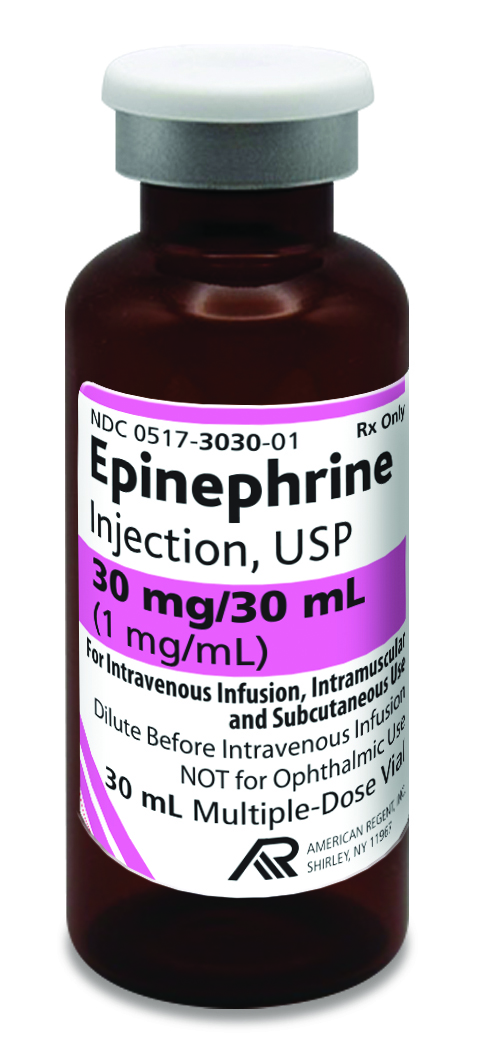Contact Us
By clicking Submit, you confirm that you accept our Privacy Policy and that you agree to your personal contact information being used to contact you and added to our database. If at any time you wish your personal information to be removed from the American Regent® database, please submit a message request to corpcommunications@americanregent.com.
IMPORTANT SAFETY INFORMATION
CONTRAINDICATIONS: None.
WARNINGS AND PRECAUTIONS
Incorrect Locations of Injection for Anaphylaxis: Injection into the anterolateral aspect of the thigh (vastus lateralis muscle) is the most appropriate location for administration because of its location, size, and available blood flow. Injection into (or near) smaller muscles, such as in the deltoid, is not recommended.
Do not administer repeated injections of epinephrine at the same site, as the resulting vasoconstriction may cause tissue necrosis.
Do not inject into buttock, digits, hands, or feet.
Serious Infections at the Injection Site: Rare cases of serious skin and soft tissue infections, including necrotizing fasciitis and myonecrosis caused by Clostridia (gas gangrene), have been reported.
Extravasation and Tissue Necrosis with Intravenous Infusion: Avoid extravasation into tissues, which can cause local necrosis. When epinephrine is administered intravenously, check the infusion site frequently.
Hypertension: Because individual response to epinephrine may vary significantly, monitor blood pressure frequently and titrate to avoid excessive increases in blood pressure. Patients receiving monoamine oxidase inhibitors or antidepressants of the triptyline or imipramine types may experience severe, prolonged hypertension.
Pulmonary Edema: Epinephrine increases cardiac output and causes peripheral vasoconstriction, which may result in pulmonary edema.
Renal Impairment: Epinephrine constricts renal blood vessels, which may result in oliguria or renal impairment.
Cardiac Arrhythmias and Ischemia: Epinephrine may induce cardiac arrhythmias and myocardial ischemia, especially in patients suffering from coronary artery disease or cardiomyopathy. May aggravate angina pectoris or produce ventricular arrhythmias.
Allergic Reactions Associated with Sulfite: The Epinephrine 30 mL multiple-dose vial contains sodium metabisulfite, which may cause mild to severe allergic reactions including anaphylaxis or asthmatic episodes in susceptible individuals.
ADVERSE REACTIONS
Common adverse reactions to systemically administered epinephrine include, but are not limited to, anxiety, apprehensiveness, restlessness, tremor, weakness, dizziness, sweating, palpitations, pallor, nausea and vomiting, headache, and respiratory difficulties. These symptoms occur in some persons receiving therapeutic doses of epinephrine, but are more likely to occur in patients with heart disease, hypertension, or hyperthyroidism.
The true incidence of adverse reactions associated with the systemic use of epinephrine is difficult to determine. Adverse reactions reported in observational trials, case reports, and studies are listed below by body system:
Cardiovascular: Angina, arrhythmias, hypertension, pallor, palpitations, tachyarrhythmia, tachycardia, vasoconstriction, ventricular ectopy, and stress cardiomyopathy. Rapid rises in blood pressure associated with epinephrine use have produced cerebral hemorrhage, particularly in elderly patients with cardiovascular disease.
Neurological: Disorientation, impaired memory, panic, psychomotor agitation, sleepiness, tingling.
Psychiatric: Anxiety, apprehensiveness, restlessness.
Other: Patients with Parkinson’s disease may experience psychomotor agitation or a temporary worsening of symptoms.
Diabetic patients may experience transient increases in blood sugar.
Injection into the buttock has resulted in cases of gas gangrene.
Rare cases of serious skin and soft tissue infections, including necrotizing fasciitis and myonecrosis caused by Clostridia (gas gangrene), have been reported following epinephrine injection in the thigh.
USE IN SPECIFIC POPULATIONS
Elderly patients and pregnant women may be at greater risk of developing adverse reactions when epinephrine is administered parenterally.
Pregnancy
May cause fetal harm.
Labor or Delivery: There are risks to the mother and fetus associated with epinephrine use during labor or delivery. Epinephrine usually inhibits spontaneous or oxytocin-induced contractions of the pregnant human uterus and may delay the second stage of labor. Avoid epinephrine during the second stage of labor. Although epinephrine may improve maternal hypotension associated with septic shock and anaphylaxis, it may result in uterine vasoconstriction, decreased uterine blood flow, and fetal anoxia.
Lactation
There is no information regarding the presence of epinephrine in human milk or the effects of epinephrine on the breastfed infant or on milk production.
Pediatric Use
Reported clinical experience with the use of epinephrine suggests that the adverse reactions seen in children are similar in nature and extent to those both expected and reported in adults.
Safety and effectiveness of epinephrine in pediatric patients with septic shock have not been established.
Geriatric Use
In general, dose selection for an elderly patient should be cautious, reflecting the greater frequency of decreased hepatic, renal, or cardiac function, and of concomitant disease or other drug therapy.
OVERDOSAGE
Overdosage of epinephrine may produce extremely elevated arterial pressure, which may result in cerebrovascular hemorrhage, particularly in elderly patients. Overdosage may also result in pulmonary edema, transient bradycardia followed by tachycardia, and these may be accompanied by potentially fatal cardiac arrhythmias. Subsidence of the ventricular effects may be followed by atrial tachycardia and occasionally by atrioventricular block. Myocardial ischemia and infarction, cardiomyopathy, extreme pallor and coldness of the skin, metabolic acidosis due to elevated blood lactic acid levels, and renal insufficiency have also been reported.
INDICATIONS AND USAGE
Anaphylaxis
Emergency treatment of allergic reactions (Type I), including anaphylaxis, which may result from insect stings or bites, foods, drugs, sera, diagnostic testing substances, and other allergens, as well as idiopathic anaphylaxis or exercise-induced anaphylaxis.
Hypotension associated with Septic Shock
To increase mean arterial blood pressure in adult patients with hypotension associated with septic shock.
For additional Safety Information, please see Full Prescribing Information.
You are encouraged to report Adverse Drug Events (ADEs) to American Regent Inc. at 1.800.734.9236 or to the FDA by visiting www.fda.gov/MedWatch or calling 1.800.FDA.1088.
